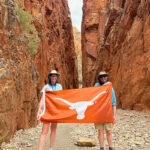The Other Bevos

When Waneen Spirduso entered the Capital of Texas Postcard show in North Austin last year, she didn’t know she would walk out with an undiscovered piece of Longhorn lore.
As she sifted through box after box, she had one goal in mind: to find vintage postcards related to The University of Texas to add to her collection. A postcard enthusiast, Spirduso, BS ’57, EdD ’66, had traveled to many cities, adding to her repertoire of rare real-photo postcards—photographic images printed on postcard stock. And on this particular day, to her amazement and delight, she discovered something special: a real-photo postcard of a longhorn steer posing with the 1941 UT football team.
There wasn’t much information on the card, other than a caption on the photo, which read: “TEXAS LONGHORNS OF 1941 AND BIG BOY THEIR MASCOT.” This gave Spirduso pause. Big Boy is not on the official list of Bevos, so she and Cindy Slater, the librarian at UT’s H.J. Lutcher Stark Center, immediately started digging into old issues of The Daily Texan, the Cactus yearbook, and the Austin American-Statesman for information that might explain what this steer was doing in the middle of a UT football team portrait. Here, Spirduso and Slater share what they discovered with the Alcalde—and how it alters the Bevo timeline as we know it.
Bevo, the mascot of UT Austin’s football team, symbolically dates back to 1916, when Bevo I, a wild, boisterous, and unruly adult longhorn steer was introduced at the last game of the season, the erstwhile annual Thanksgiving meeting between Texas and Texas A&M. He didn’t return the following season, nor the one after. It wasn’t until 1920 that Bevo I made another appearance—this time on the barbecue pit. Sixteen years later, Texas presented his successor, Bevo II, but he, too, did not peacefully accept the transference from his wild Texas cattle range to 100 yards of short grass surrounded by thousands of screaming people. Like Bevo I, Bevo II had a surly attitude, and was banned from football appearances after one year.
At this point the lineage of Bevo begins to get a little murky. Research suggests that there may have been unofficial Bevos that don’t fit with the generally accepted timeline of succession that brings us from Bevo I to our current favorite steer, the adolescent Bevo XV. Of these unacknowledged Bevos, the one that stands out most, perhaps, is the biggest one of all.
Between 1917 and 1932 there was no live Bevo. Between 1932 and 1945 historical reports suggest there was a Bevo III and even a Bevo IV, but it was not until 1945 that Bevo historians agreed on a designated Bevo III. However, based on 12 news articles and photographs published in The Daily Texan and the Cactus, evidence abounds that there were indeed two steers that were considered mascots during that 13-year gap. The first was a small, light red-and-white steer, not a longhorn, but described as “mascot-for-a-day” at the Oct. 26, 1935, football game against Rice at Memorial Stadium. This little Hereford-Brahman steer, which may or may not have been the same steer that appeared as Texas’ mascot from 1935 to 1939, was described as Bevo III. Although he was scraggly and had no horns, he attended pep rallies and bonfires and was photographed with a pep banner reading “BEVO III” on his back. He also led the UT pep rally parades on Fridays before the big game.

A thread posted on Reddit/r/LonghornNation in 2015 illustrated the lack of awareness of the second unremembered steer. He was Big Boy, a gigantic Longhorn steer who appeared in photographs and articles in both the Texan and the 1942 Cactus. A 10-by-12 photograph of Big Boy surrounded by the football team inauspiciously resides in the back on the lowest shelf of the Silver Spurs’ Bevo exhibit in the foyer of The University of Texas Club. Big Boy was everything a Longhorn fan could want as a mascot. He was 6 feet tall, weighed 3,380 pounds, and had a tip-to-tip horn span of 79 inches. He was 15 years old, and therefore, thank goodness, docile.
In a Dec. 4, 1941 Texan article, he was introduced as the new mascot of the football team. Three days later, after Texas routed Oregon 71-7, a reporter hailed Big Boy in the Texan, “Next to the score, the biggest thing on the field was Big Boy, The Largest Steer in the Largest State.” At halftime, he paraded around the field carrying a drum majorette and two Cowboys on his back. Before the game, a traveling photographer took pictures with the bandsmen on Big Boy’s back. Those photos have yet to be found, but the photograph that has survived and that defends his proposed inclusion in the Bevo historical record, is that of Big Boy surrounded on both sides by the entire 1941 Texas football team, while sporting the four starting backfield players on his back. That team would go 8-1-1 under coach Dana X. Bible and though multiple polling systems declared the No. 4 Longhorns as national champions, Texas doesn’t claim the title among its other four.
Perhaps, because the Hereford-Brahman steers that were described in 1932-33 were scrawny and little, or because they had no horns, or because they were indeed not longhorns, these little steers never made the historical list of Bevos. But Big Boy was a different matter. He was described as the “beloved” mascot of one of the greatest football teams ever to play for UT.
They were the first UT team to be ranked No. 1 by all three national polls. All 11 of the starters and three reserves graced the cover of the Nov. 17, 1941, issue of Life magazine, which at that time sold over a million copies per week. The team included four future NFL players, including first-team All-American end Mal Kutner, who was eventually inducted into the College Football Hall of Fame.

Additionally, the team photograph with the players on his back appears to be the only one selected by the photographer to be printed as a real photo postcard, making Big Boy most likely the first Longhorn mascot ever to be featured on a postcard. Big Boy seemed to be a favorite of the football team, who referred to him as “our big boy.” One of the players supposedly said, “This is how the big boys play the game.” There is no sign that Big Boy ever received the official designation of Bevo, however. Considering that in 1941 he was the grandest symbol of all that is The University of Texas spirit and that he was adopted by the team with one of the finest seasons in Texas football history, shouldn’t Big Boy be included in the official history of UT mascots? Maybe, in order to leave the line of succession undisturbed, he could be given a nickname without a number. How about Big Boy Bevo? Has a ring to it, doesn’t it?

















No comments
Be the first one to leave a comment.